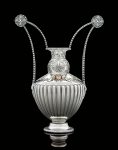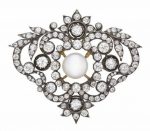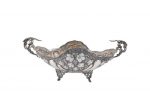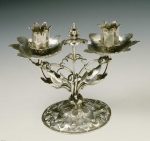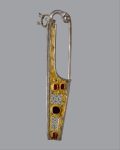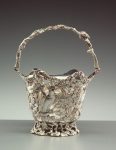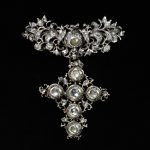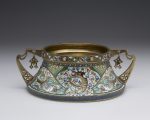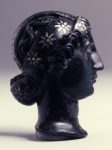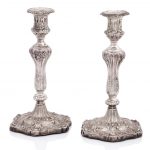Openwork or open-work is a term in art history, architecture and related fields for any technique that produces decoration by creating holes, piercings, or gaps that go right through a solid material such as metal, wood, stone, pottery, cloth, leather, or ivory. Such techniques have been very widely used in a great number of cultures.
The term is rather flexible, and used both for additive techniques that build up the design, as for example most large features in architecture, and those that take a plain material and make cuts or holes in it. Equally techniques such as casting using moulds create the whole design in a single stage, and are common in openwork. Though much openwork relies for its effect on the viewer seeing right through the object, some pieces place a different material behind the openwork as a background. Reference: Wikipedia. Below are some examples of openwork in silver wares.
A pair of Victorian sterling silver vintage-decorated wine bottle coasters marks rubbed, Sheffield, 1840 The sides with openwork fruiting grapevines, border with cast branch and vine, and the foot with a ribbon tied reeded band, with wooden bases, diameter 7in (18cm).
Sold for US$ 2,125 (£ 1,595) inc. premium at Bonhams in 2018
Mount; silver-gilt; rectangular; relief openwork decoration with engraved silver strip between; openwork casing engraved with diamond-shaped flower petals, and with openwork quatrefoils; one end has a hinge, the other (broken) has two rivets.
Reference: © The Trustees of the British Museum
1900 PARIS EXPOSITION UNIVERSELLE: AN AMERICAN SILVER AND ENAMEL “POMPEIAN” VASE MARK OF TIFFANY & CO., NEW YORK, 1900, DESIGNED BY PAULDING FARNHAM On spreading circular base with gadrooned rim, rising to a amphora-form body chased with lobes spaced by reeded arches, the shoulders enameled with stylized red lyres and yellow flowers above scrolling green foliage, neck chased with shells and flowering vines, the upswung openwork handles cast with climbing vines and terminating in two swan heads, the handles topped by stylized pierced rosettes, marked on underside, numbered 13899-1120 and with 1900 Paris Exposition mark 18 ½ in. (47 cm.) high 98 oz. 16 dwt. (3,073 gr.)
Sold for USD 31,250 at Christies in 2019
Antique Silver, Gold, Cultured Pearl and Diamond Pendant-Brooch The openwork garland accented by 10 old European-cut diamonds approximately 3.85 cts., set throughout with 112 old-mine cut diamonds approximately 7.50 cts., centering one button pearl approximately 11.85 mm., center pearl and setting not original, approximately 18.5 dwts. With GIA report no. 6192714159 stating that the pearl is bead cultured, saltwater, no indications of treatment.
Sold for $4,375 (includes buyer’s premium) at Doyle New York in 2018
A 20th century Greek sterling silver twin-handled bowl, stamped 925 and with a maker’s mark Of shaped oval form, embossed with fruiting vine, with leaf-capped openwork handles, raised on four openwork feet. Length – 31.5 cm / 12.4 inches Weight – 433 grams / 13.92 ozt
Sold for £130 at Chiswick Auctions in 2019
This candlestick, a fine example of the Parisian goldsmith’s art in the first half of the 17th century, is one of the few known works by François Roberday the elder, goldsmith to the Duke of Orleans. The work was evidently based on the engravings of metalwork designs that goldsmiths used as models. The openwork motifs are typical of the “cosse de pois,” or peapod, style, which was then fashionable among goldsmiths working for the Crown. A candlestick dating from the first half of the 17th century The candlestick has a circular base, made from a sheet of pierced silver, that forms a double openwork rosette of peapod-style ornaments. The central stalk rises from a crown of leaves and is divided into several branches. It terminates in a small handle shaped like a cluster of flowers. On either side are lateral branches that pass through open peapods. Both branches are topped by a candle-ring in the shape of a corolla and a hexagonal candleholder with six petals. Slender tendrils decorated with peapods and peas entwine the main branches. The abundance of leaves and tendrils make this work a typical example of the Parisian goldsmith’s art in the first half of the 17th century.
Reference:The Louvre
Archaeological finds in ancient Mesopotamia indicate that filigree was incorporated into jewelry since 3,000 BC. Specific to the city of Midyat in Mardin Province in upper Mesopotamia, a form of filigree using silver and gold wires, known as “telkari”, was developed in the 15th Century. To this day, expert craftsmen in this region continue to produce fine pieces of telkari.The Egyptian jewelers employed wire, both to lay down on a background and to plait or otherwise arranged jour. But, with the exception of chains, it cannot be said that filigree work was much practiced by them. Their strength lay rather in their cloisonné work and their molded ornaments. Many examples, however, remain of round plaited gold chains of fine wire, such as those that are still made by the filigree workers of India, and known as trichinopoly chains. From some of these are hung smaller chains of finer wire with minute fishes and other pendants fastened to them. Reference: Wikipedia
This richly decorated brooch, wrought in silver, is an exceptional example of a type of brooch made in the Roman border province of Pannonia, on the Danube River. These objects are called “wing brooches” because of the winglike extensions that flank the knob at the bend of the bow. On this work, the knob is decorated with a zigzag pattern, and the two wings are adorned with two small knobs. A punchwork design extends from the knob along the length of the bow. As is typical of the few other surviving examples of this quality, the large, trapezoidal catch plate is covered with gold foil, except where it is pierced with elaborate patterns. Twisted gold wire laid down in wavy lines and scroll-and-heart motifs decorate the foil. Four carnelians frame the two intricate openwork patterns near the tip of the catch plate—one of linked circles and one of linked hearts. Rounded and rosette-shaped silver studs also ornament the surface. Except for minor losses to the gold foil, the brooch is complete and in excellent condition. On the basis of burial and pictorial evidence, wing brooches like this one were worn by women in pairs, on the shoulder, with the intricately pierced catch plates protruding above their robes, creating a relatively delicate, patterned effect.
Reference: The Metropolitan Museum of Art
Sterling silver basket Made by Walsh & Sons in Melbourne, Victoria, Australia, 1859-1865. The son of a London silversmith, William Edwards migrated to Melbourne in 1857 to become a leading supplier of silverware -either imported or made in his workshop – initailly from from his premises in Collins Street East, until about 1876. This basket is the earliest object Edwards stamped with his Australian marks and was probably made by him not long after his arrival. This basket is a pair to a very similar piece (with a ruby glass liner) also in this collection, bearing William’s English marks. The English basket, which he must have brought with him, provided inspiration for its Australian pair.
Reference: Museum of Applied Art and Sciences
Bouquet holder probably French mid-19th century
Silver bouquet holder with openwork design.
Reference: Museum of Fine Arts Boston
A Bezalel silver filigree Esther Scroll case, Jerusalem, circa 1920 engraved signature on pull, case only, no scroll, openwork crown finial length 7 5/8 in. 9.3 cm
Sold for 2,750 USD at Sothebys in 2018
Pendant cross, with rock crystal doublets and glass set in silver openwork, probably made in Germany, 1750-1800
Reference: © Victoria and Albert Museum
The overall shape of the bowl, with its flaring walls and openwork handles, is in stil moderne (Russian Art Nouveau). On both faces, brownish yellow sea monsters, toying with pink balls in their jaws, swim amidst pink and blue jetsam in a turquoise field. These creatures are flanked by irregularly shaped reserves containing nautical scenes, each including a sailboat with a peacock prow; a swan; a blue fish, and a landscape. The bowl’s rim is encircled by a band of tulip blossoms, threads of wire terminating in raised dots, and wire scrolls all against a blue and green ground. A row of gilt wire scrolls set against a blue ground borders the bowl’s bottom edge. From the plain, silver gilt handles with pierced circular decoration, dangle pendants.
Reference: The Walters Art Museum


